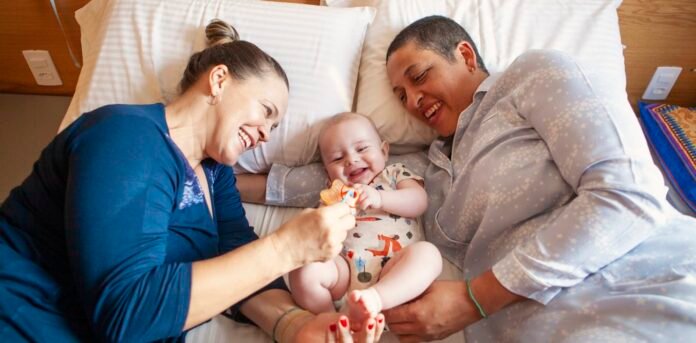Last week, scientists announced the birth of eight healthy babies in the United Kingdom conceived with DNA from three people. Some headlines have called it “three-person IVF”.
The embryo uses the DNA from the egg and sperm of the intended father and mother, as well as cells from the egg of a second woman (the donor).
This process – known as mitochondrial replacement therapy – allows women with certain genetic disorders to conceive a child without passing on their condition.
While it’s raised broader questions about “three-parent” babies, it’s not so simple. Here’s why it’s unlikely this development will transform the diverse ways LGBTQ+ people are already making families.
What this technology is – and isn’t
The UK became the first country in the world to allow mitochondrial donation for three-person embryos ten years ago, in 2015.
In other countries, such donations are banned or strictly controlled. In Australia, a staged approach to allow mitochondrial donation was introduced in 2022. Stage one will involve clinical trials to determine safety and effectiveness, and establish clear ethical guidelines for donations.
These restrictions are based on political and ethical concerns about the use of human embryos for research, the unknown health impact on children, and the broader implications of allowing genetic modification of human embryos.
There are also concerns about the ethical or legal implications of creating babies with “three parents”.
Carefully and slowly considering these ethical issues is clearly important. But it’s inaccurate to suggest this process creates three parents.
First, the amount of DNA the donor provides is tiny, only 0.1% of the baby’s DNA. The baby will not share any physical characteristics with the donor.
While it is significant that two women’s DNA has been used in creating an embryo, it doesn’t mean lesbian couples will be rushing to access this particular in vitro fertilisation (IVF) technology.
This technique is only used for people affected by mitochondrial disease and is closely regulated. It is not available more widely and in Australia, is not yet available even for this use.
Second, while biological lineage is an important part of many people’s identity and sense of self, DNA alone does not make a parent.
As many adoptive, foster and LGBTQ+ parents will attest, parenting is about love, connection and everyday acts of care for a child.
How do rainbow families use IVF?
Existing IVF is already expensive and medically invasive. Many fertility services offer a range of additional treatments purported to aid fertility, but extra interventions add more costs and are not universally recommended by doctors.
While many lesbian couples and single women use fertility services to access donor sperm, not everyone will need to use IVF.
Less invasive fertilisation techniques, such as intrauterine insemination, may be available for women without fertility problems. This means inserting sperm directly into the uterus, rather than fertilising an egg in a clinic and then implanting that embryo.
Same-sex couples who have the option to create a baby with a sperm donor they know – rather than from a register – may also choose home-based insemination, the proverbial turkey baster. This is a cheaper and more intimate way to conceive and many women prefer a donor who will have some involvement in their child’s life.
In recent years, “reciprocal” IVF has also grown in popularity among lesbian couples. This means an embryo is created using one partner’s egg, and the other partner carries it.
Reciprocal IVF’s popularity suggests biology does play a role for LGBTQ+ women in conceiving a baby. When both mothers share a biological connection to the child, it may help overcome stigmatisation of “non-birth” mothers as less legitimate.
But biology is by no means the defining feature of rainbow families.
LGBTQ+ people are already parents
The 2021 census showed 17% of same-sex couples had children living with them; among female same-sex couples it was 28%. This is likely an underestimate, as the census only collects data on couples that live together.
Same-sex couples often conceive children using donor sperm or eggs, and this may involve surrogacy. But across the LGBTQ+ community, there are diverse ways people become parents.
Same-sex couples are one part of the LGBTQ+ community. Growing numbers of trans and non-binary people are choosing to carry a baby (as gestational parents), as well as single parents who use donors or fertility services. Many others conceive children through sex, including bi+ people or others who conceive within a relationship.
While LGBTQ+ people can legally adopt children in Australia, adoption is not common. However, many foster parents are LGBTQ+.
When they donate eggs or sperm to others, some LGBTQ+ people may stay involved in the child’s life as a close family friend or co-parent.
Connection and care, not DNA
While mitochondrial replacement therapy is a remarkable advance in gene technology, it is unlikely to open new pathways to parenthood for LGBTQ+ people in Australia.
Asserting the importance of families based on choice – not biology or what technology is available – has been crucial to the LGBTQ+ community’s story and to rainbow families’ fight to be recognised.
Decades of research now shows children raised by same-sex couples do just as well as any other child. What matters is parents’ consistency, love and quality of care.






